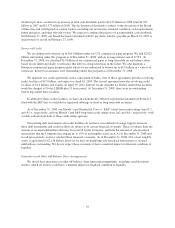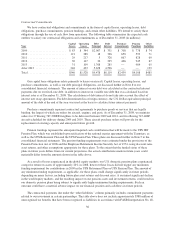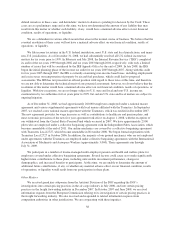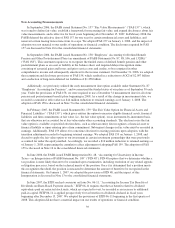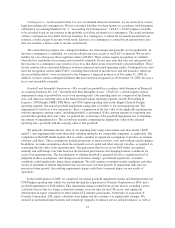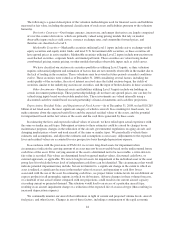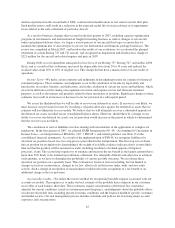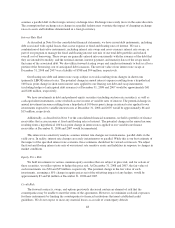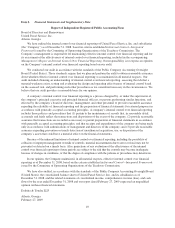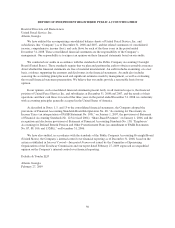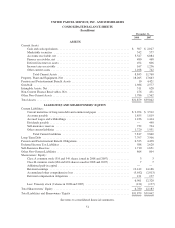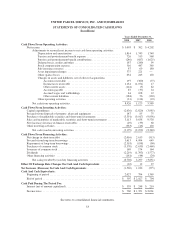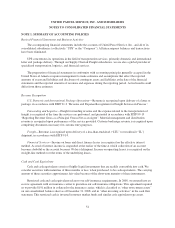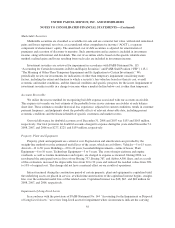UPS 2008 Annual Report Download - page 56
Download and view the complete annual report
Please find page 56 of the 2008 UPS annual report below. You can navigate through the pages in the report by either clicking on the pages listed below, or by using the keyword search tool below to find specific information within the annual report.decline experienced in the second half of 2008, could result in modifications to our current aircraft fleet plan.
Such modifications could result in a reduction in the expected useful life of an aircraft type or in impairment
losses related to the early retirement of particular aircraft.
As a result of business changes that occurred in the first quarter of 2007, including capacity-optimization
programs in our domestic and international air freight forwarding business as well as changes to our aircraft
orders and planned delivery dates, we began a review process of our aircraft fleet types to ensure that we
maintain the optimum mix of aircraft types to service our international and domestic package businesses. The
review was completed in March 2007, and based on the results of our evaluation, we accelerated the planned
retirement of certain Boeing 727 and 747 aircraft, and recognized an impairment and obsolescence charge of
$221 million for the aircraft and related engines and parts in 2007.
During 2006, we reevaluated the anticipated service lives of our Boeing 757, Boeing 767, and Airbus A300
fleets, and as a result of this evaluation, increased the depreciable lives from 20 to 30 years and reduced the
residual values from 30% to 10% of original cost. This change did not have a material effect on our results of
operations.
Income Taxes—We make certain estimates and judgments in determining income tax expense for financial
statement purposes. These estimates and judgments occur in the calculation of income by legal entity and
jurisdiction, tax credits, benefits, and deductions, and in the calculation of certain tax assets and liabilities, which
arise from differences in the timing of recognition of revenue and expense for tax and financial statement
purposes, as well as the interest and penalties related to these uncertain tax positions. Significant changes to these
estimates may result in an increase or decrease to our tax provision in a subsequent period.
We assess the likelihood that we will be able to recover our deferred tax assets. If recovery is not likely, we
must increase our provision for taxes by recording a valuation allowance against the deferred tax assets that we
estimate will not ultimately be recoverable. We believe that we will ultimately recover a substantial majority of
the deferred tax assets recorded on our consolidated balance sheets. However, should there be a change in our
ability to recover our deferred tax assets, our tax provision would increase in the period in which we determined
that the recovery was not likely.
The calculation of our tax liabilities involves dealing with uncertainties in the application of complex tax
regulations. In the first quarter of 2007, we adopted FASB Interpretation No. 48, “Accounting for Uncertainty in
Income Taxes—an interpretation of SFAS No. 109” (“FIN 48”), and related guidance (see Note 13 in the
consolidated financial statements). As a result of the implementation of FIN 48, we recognize liabilities for
uncertain tax positions based on a two-step process prescribed in the interpretation. The first step is to evaluate
the tax position for recognition by determining if the weight of available evidence indicates that it is more likely
than not that the position will be sustained on audit, including resolution of related appeals or litigation
processes, if any. The second step requires us to estimate and measure the tax benefit as the largest amount that is
more than 50% likely to be realized upon ultimate settlement. It is inherently difficult and subjective to estimate
such amounts, as we have to determine the probability of various possible outcomes. We reevaluate these
uncertain tax positions on a quarterly basis. This evaluation is based on factors including, but not limited to,
changes in facts or circumstances, changes in tax law, effectively settled issues under audit, and new audit
activity. Such a change in recognition or measurement would result in the recognition of a tax benefit or an
additional charge to the tax provision.
Accounts Receivable—We utilize the reserve method for recognizing bad debt expense associated with our
accounts receivable. This requires us to make our best estimate of the probable losses inherent in our customer
receivables at each balance sheet date. These estimates require consideration of historical loss experience,
adjusted for current conditions, trends in customer payment frequency, and judgments about the probable effects
of relevant observable data, including present economic conditions and the financial health of specific customers
and market sectors. Our risk management process includes standards and policies for reviewing major account
exposures and concentrations
45


